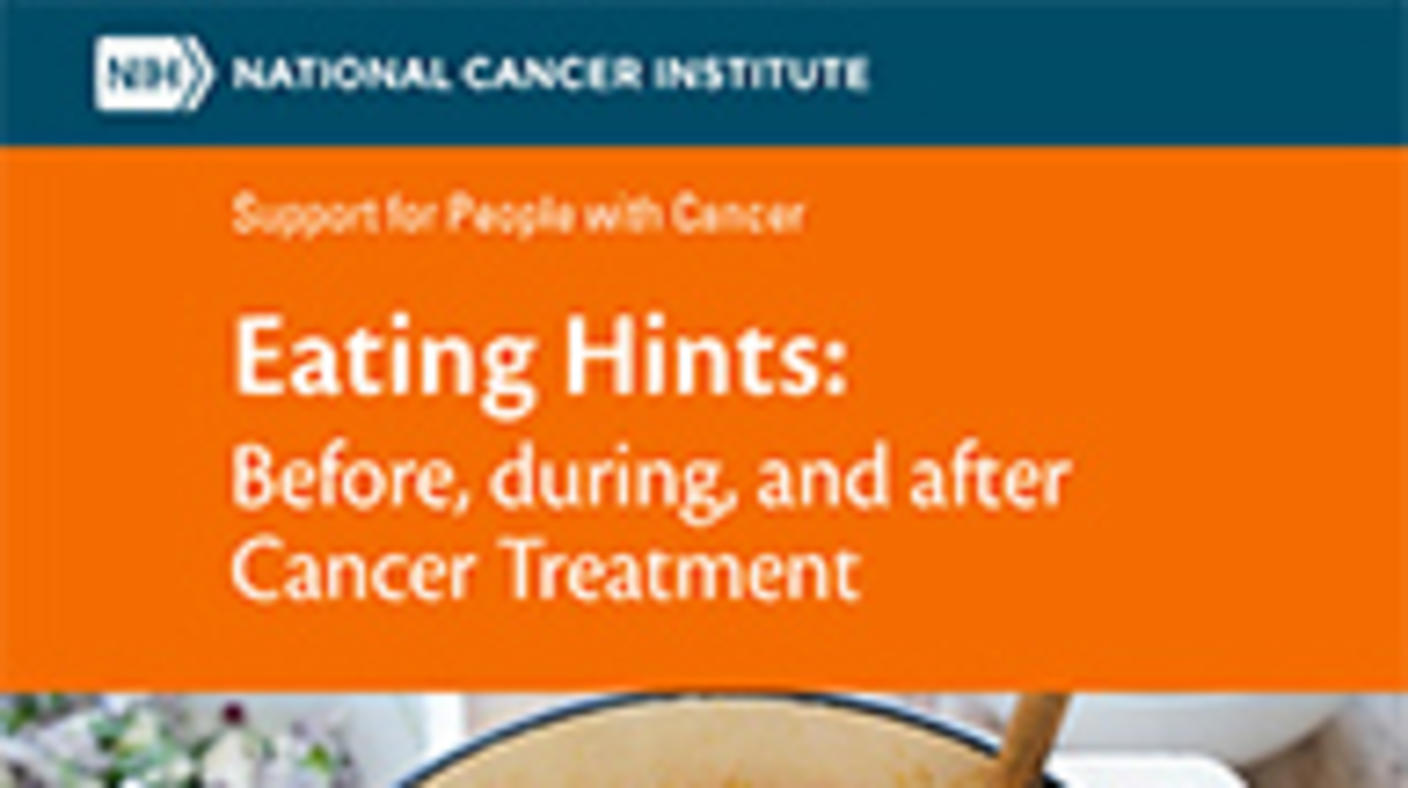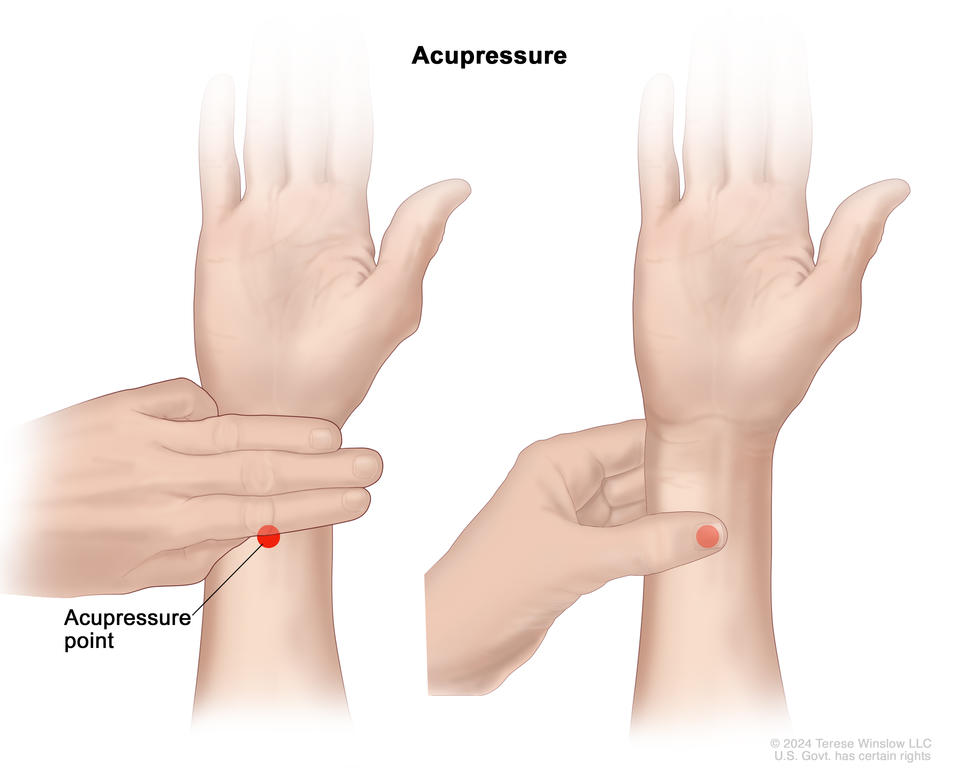What are nausea and vomiting?
Nausea is when you feel sick to your stomach, as if you have the urge to throw up. Vomiting is when you throw up. Nausea and vomiting are common side effects of cancer treatments, including chemotherapy (chemo) and radiation therapy, but antinausea medicines often prevent or relieve nausea and vomiting before they start or become a problem.
If uncontrolled, vomiting can lead to serious health problems such as dehydration, electrolyte imbalances, and weight loss. Before you begin treatment, your doctor may suggest medications and tips to prevent and control these side effects.
Nausea and vomiting can occur at different times during cancer treatment:
- Acute nausea and vomiting happen within 24 hours after treatment starts.
- Delayed nausea and vomiting happen 1 to 7 days after treatment. This is also called late nausea and vomiting.
- Anticipatory nausea and vomiting happen before treatment begins. If you have had nausea and vomiting after an earlier treatment session, the smells, sights, and sounds of the treatment room during a later session may trigger nausea and vomiting before the session begins.
- Chronic nausea and vomiting are ongoing after treatment ends.
Nausea and vomiting may also be described based on how well antinausea medicines work against them:
- Breakthrough nausea and vomiting happen within 5 days of starting antinausea treatment.
- Refractory nausea and vomiting do not get better with antinausea medications.
What causes nausea and vomiting in people with cancer?
Cancer and cancer treatments can cause nausea and vomiting. Other causes include anxiety, pain medicines, taking certain medications on an empty stomach, and other medical conditions.
Nausea and vomiting from cancer
Nausea and vomiting may be a sign or symptom of some types and stages of cancer:
- cancers in the abdomen
- brain and central nervous system cancers
- advanced cancer
- cancer that has spread to the bones
Nausea and vomiting from cancer treatments
Many cancer treatments cause nausea and vomiting, but antinausea medicines (also known as antiemetics) given before treatment sessions work well to prevent or reduce these side effects.
- Chemotherapy often causes nausea and vomiting. Nausea and vomiting from chemo may begin a few minutes to a few hours after treatment begins or be delayed and occur a day or more after treatment. Nausea and vomiting from chemotherapy usually last 24 to 48 hours, but some people may feel sick for up to 7 days after treatment. You will usually receive antinausea medicines before chemotherapy starts because once nausea and vomiting from chemotherapy develop, they are more difficult to treat.
- Radiation therapy can cause nausea and vomiting, especially when radiation is directed at the brain, upper abdomen, or whole body. People receiving higher doses of radiation may be more likely to experience these side effects. You may begin feeling sick a few hours after each treatment session, and nausea and vomiting may last for three to four weeks.
- Targeted therapy and immunotherapy drugs can bring on nausea and vomiting. You may start to feel sick during treatment or after it has ended. As with chemotherapy, it’s important to prevent nausea and vomiting by taking antinausea medicines before treatment starts.
- Bone marrow or stem cell transplant can cause nausea and vomiting because you will receive large amounts of chemo, radiation, or both before a transplant. Nausea and vomiting can also be signs of graft-versus-host disease or infection, which are possible complications of bone marrow transplants.
- Surgery may lead to nausea and vomiting caused by side effects of anesthesia and pain medicines given after surgery. Nausea and vomiting after surgery may last 24 to 48 hours.
How to prevent and stop nausea and vomiting
Medicines for nausea and vomiting
Medicines called antiemetics (or antinausea drugs) work well to prevent and relieve nausea and vomiting in people with cancer. Your doctor may prescribe multiple types of antiemetics you can take depending on the severity of your nausea and vomiting. Your doctor will also tell you when to take the antiemetics, such as before or after chemotherapy treatments or a certain amount of time before eating.
Many types of antiemetics can prevent or help you get relief from nausea and vomiting, and you may be prescribed these or others that are not listed:
- drugs that block serotonin, a chemical in the brain that can trigger nausea and vomiting: ondansetron (Zofran), granisetron (Kytril), dolasetron (Anzemet), palonosetron (Aloxi)
- drugs that block dopamine, a chemical in the brain that can trigger nausea and vomiting: chlorpromazine, prochlorperazine (Compazine), promethazine (Phenergan), metoclopramide (Reglan)
- drugs that block the NK-1 receptor, a protein in the brain that can trigger nausea and vomiting: aprepitant or fosaprepitant (Emend)
- steroids: dexamethasone (Decadron), methylprednisolone (Medrol)
- benzodiazepines, which can prevent anxiety-related nausea and vomiting: alprazolam (Xanax), lorazepam (Ativan)
- antipsychotics, which block multiple areas in the brain that can cause nausea and vomiting: olanzapine (Zyprexa)
- cannabinoids, which contain THC and can help relieve nausea and vomiting: dronabinol (Marinol)
Tips for managing nausea and vomiting
In addition to prescribing antinausea medicines, your doctor may suggest tips for managing nausea and vomiting. These tips may sometimes be called natural nausea relief.
- Drink plenty of fluids. Drinking water or clear liquids will help prevent dehydration, a serious problem that happens when your body loses too much fluid from vomiting and you are not drinking enough. Try to sip on water, broth, fruit juices, ginger ale, tea, and/or sports drinks throughout the day. If you are losing weight without trying, drink fluids with calories instead of water.
- Eat foods that are easy on your stomach. Try cold foods such as popsicles, pudding, yogurt, and gelatin. Try bland, starchy foods such as toast, rice, plain pasta, crackers, and pretzels. Foods and beverages with ginger, such as ginger ale and ginger tea, may also ease nausea and vomiting. Learn more about eating tips to help you avoid nausea and vomiting while you are undergoing cancer treatment at Nutrition During Cancer Treatment.
- Avoid certain foods. Don’t eat greasy, fried, sweet, or spicy foods if you feel sick after eating them.
- Avoid strong odors when eating. Foods with strong odors you may want to avoid include coffee, fish, onions, and garlic. If the smell of food bothers you, ask others to make your food. Eating in a well-ventilated room free of strong food smells, perfume, or scented candles may also help.
- Eat smaller meals more frequently throughout the day. Try to eat five to six small meals rather than three larger meals.
- Eat in a peaceful, relaxing space. After eating, try resting while seated upright or lying down with your head elevated for 30 minutes to help reduce nausea and vomiting.
- Keep a record of when you feel nauseous and what you did or ate before that. This can help your doctor or nurse figure out what brings on nausea and vomiting.
- Practice relaxation techniques. Deep breathing, guided imagery, hypnosis, massages, listening to music, and meditating can all help reduce nausea and vomiting in people with cancer. Ask your nurse about programs that may be available in your community or at the hospital where you are receiving treatment.
- Ask your doctor about acupuncture and acupressure. Acupuncture uses needles to stimulate certain points in the body that can help relieve symptoms and must be done by a professional acupuncturist. You can do acupressure on yourself by finding a specific point in your wrist and applying pressure. You can also wear Sea-Band wristbands, which stimulate acupressure points, and may help relieve nausea.
If you want to try supplements or complementary and alternative medicines to ease nausea and vomiting, always check with your doctor first. Some supplements and alternative therapies may cause cancer treatments to work less well.
How a caregiver can help
- Make meals for the person you are caring for if they are feeling nauseous or if the smell of food makes their symptoms worse. Be sure the kitchen is ventilated to decrease food smells.
- Have the person eat with plastic utensils instead of metal ones, which can taste bitter. Finger foods are also an option.
- Ask the person’s doctor about medicines that can help reduce or prevent nausea and vomiting.
- Help the person you are caring for take their antinausea medicine at the right times. For example, the doctor may recommend some medicines be taken before or after treatment or a certain amount of time before a meal.
- Monitor the person for dizziness, weakness, or confusion, which are all signs of dehydration.
- Encourage the person to sip clear liquids slowly throughout the day to avoid constipation and dehydration, which can worsen nausea and vomiting.
Nausea and vomiting in children being treated for cancer
Nausea and vomiting are serious side effects of cancer treatment for children. You can learn about how to help your child avoid nausea and vomiting during cancer treatment in our booklet Children with Cancer: A Guide for Parents in the section Common Health Problems.
Nausea and vomiting in children can be treated with many of the same medicines and techniques used in adults. But not all medicines for adults are safe for children to take, and children are often given lower doses.
Doctors have also found that several integrative therapies may be especially effective for treating nausea and vomiting in children:
- hypnosis and guided imagery
- music therapy
- support groups
- virtual reality games
Be aware of delayed nausea and vomiting in children being treated for cancer
Delayed nausea, or nausea and vomiting that happens more than 24 hours after a cancer treatment, may be more difficult to notice in children than in adults. A change in the child’s eating pattern may be the only sign of a problem. In addition, most chemotherapy treatments for children are scheduled over several days. This makes the timing and risk of delayed nausea difficult to predict.
Talk with your child’s health care team if your child has nausea or vomiting or if you notice a sudden change in their eating habits. Your child’s doctors can help you determine if these changes are related to the cancer treatment and identify strategies to help manage them.
Talking with your doctor about nausea and vomiting
If you are experiencing nausea and vomiting or are worried about having these side effects, tell your health care team. They can help you find ways to get relief or prevent nausea and vomiting before it starts.
Questions to ask your provider about nausea and vomiting:
- What symptoms or problems should I call you about?
- What medicine could help me? When should I take this medicine?
- How much liquid should I drink each day? What should I do if I throw up?
- What foods would be easy on my stomach? What foods should I avoid?
- How can I meet with a registered dietitian to learn more?
- What specialists could I see to learn about acupuncture and other natural treatments that could improve my symptoms?
Getting support if you have nausea and vomiting
Side effects like nausea and vomiting can be hard to deal with, both physically and emotionally. It’s important to ask for support from your health care team. They can help you prepare for and make it through difficult times. Learn more about ways to cope with cancer.
For family members and friends who are caring for someone with cancer, you may find these suggestions for caregivers to be helpful.


